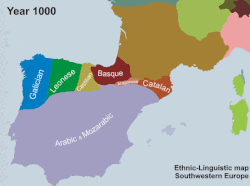| Catalan / Valencian cultural domain |
|---|
 |
The Catalan language originated from Vulgar Latin in the Pyrenees Mountains between France and Spain. It diverged from the other Romance languages in the 9th century.[1] At that time, Catalan spread quickly throughout the Iberian peninsula when the Catalan counts conquered Muslim territory.[1] By the 11th century, the Catalan language was present in several feudal documents.[2] Catalan was present throughout the Mediterranean by the 15th century. At that time, the city of Valencia was thriving.[1]
In 1659, the Treaty of Pyrenees was signed, beginning a suppression of the Catalan language. Louis XIV issued a decree that prohibited the use of the Catalan language in Northern Catalonia.[3] The repression continued during the French Revolution when the First French Republic prohibited the usage of Catalan in linguistic education.[4] The repression continued until recently, when finally the government body of the Pyrénées-Orientales in 2007 symbolically recognized the usage of Catalan publicly and its presence in education.[5]
In Spain, Catalan was expelled from the official sphere, until it regained official status after the establishment of the Autonomous Region of Catalonia within the Second Spanish Republic (1931-1939). In Francoist Spain, Catalan was prohibited in government or education, accompaigned with a harsh repression and discouragement of the public use of the language during the first years of the Dictatorship. It was initially prohibited in mass media, but then tolerated during the 1950s, including the publishing of written works in Catalan.[6] Since the death of Franco and the subsequent adoption of the Spanish constitutional monarchy, Catalan was restored as official language and since then has been promoted in different degrees by the autonomous governments of the Catalan-speaking areas (Catalonia, the Balearic Islands and Valencia). Today, despite the efforts to re-normalize the social use of the language (particularly in Catalonia) and their relative successes of the first decades, Catalan still faces issues of diglossia and increasing minorization, alongside the growth of discrimination cases.[7]
- ^ a b c Costa Carreras & Yates 2009, pp. 6–7.
- ^ Moran 2004, pp. 37–38.
- ^ "L'interdiction de la langue catalane en Roussillon par Louis XIV" [The Ban on the Catalan Language in Roussillon by Louis XIV] (PDF). CRDP, Académie de Montpellier (in French). Archived from the original (PDF) on 2010-12-14.
- ^ Abbé Grégoire. "Report on the necessity and means to annihilate the patois and to universalize the use of the French language". Languefrancaise.net. Archived from the original on 2006-11-23.
- ^ "Charte en faveur du Catalan". Conseil Général des Pyrenées Orientales. Archived from the original on December 22, 2012.
- ^ Ross, Marc Howard (2007). Cultural Contestation in Ethnic Conflict. Cambridge, UK: Cambridge University Press. p. 139. ISBN 978-0-52169-032-4.
- ^ Cebrián, Joan (15 July 2022). "El català, el quart motiu de discriminació a Barcelona". Ara.cat. Retrieved 29 May 2024.